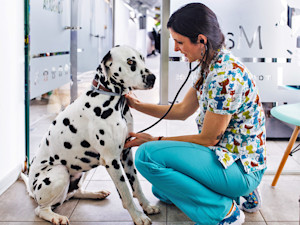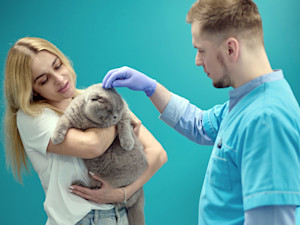Does Pet Insurance Cover Vet Visits?
If yours doesn’t, there are ways to get coverage. Here’s what to know.
In This Article:
What Is Typically Covered by Pet Insurance? Are Vet Visits Covered by Pet Insurance? Conditions and Exclusions in Coverage Which Insurance Policies Cover Vet Visits? Alternatives to Pet Insurance for Vet Visits
As the cost of veterinary care continues to rise — the average cost for a standard office exam is $100 in some areas — pet insurance that covers office visits is appealing to pet parents. Add in lab work, vaccines, diagnostics, and treatments, and the cost goes up even more.
Dr. Liza Cahn, a veterinarian at Embrace Pet Insuranceopens in new tab, says that as veterinary costs increase, more pet parents are buying insurance. “Pet insurance coverage for vet visits depends on the type of visit and the specific policy,” she says. “Whether to include exam fee coverage is a personal choice, depending on each pet parent’s unique needs and circumstances.”
How much do you spend on your pet per year?
What is typically covered by pet insurance?
When I bought my first pet insurance policy 20 years ago for my 100-pound Pitweiler, Grendel, she was covered for unexpected costs such as accidents, illnesses, emergency care, and surgeries. It came in handy when she needed ACL surgery, but it didn’t cover annual exams and vaccinations.
Typical standard plans today cover accidental injuries such as broken bones, swallowed objects, bite wounds, and trauma — plus illness and disease, diagnostic testing, surgeries, and hospitalization related to those issues. They also cover euthanasia related to trauma and diagnosed conditions. Prescriptions including specialized diets and medications related to allowable accidents and illnesses are covered by many, but not all, plans. Embrace Pet Insurance covers visits for unexpected illnesses and accidents as part of its standard plan, while annual wellness exams, vaccinations, flea and tick prevention, dental cleaning, and spaying/neutering are covered through optional add-on wellness plans.
If you think you can afford annual exams and vaccinations, a standard plan might be right for you. Research if your plan covers routine office visits, or consider one of the many optional add-ons (known as riders) for wellness coverage.
Dr. Cahn recommends buying insurance early in your pet’s life, when they’re young, healthy, and less likely to have preexisting medical conditions that may be excluded from coverage. Research your breed’s predisposition to illnesses. “Pet insurance may be the most beneficial if your pet is at higher risk of developing an illness based on their breed or lifestyle, if unexpected veterinary costs would be financially difficult, or if you are looking for peace of mind and security that your pet will be able to receive the care they need,” she says.
If you have an older pet with multiple preexisting conditions or are financially able to cover large and unexpected veterinary costs, insurance might not be necessary, Cahn says. “However, there are still plenty of insurance coverage options available for older pets, and age alone should not be a reason to rule out protecting them,” she says.
Are vet visits covered by pet insurance?
That depends on why you’re at the vet. If your puppy needs to be X-rayed because they ate something that made them sick (which turned out to be pea gravel) or they’re full of porcupine quills, your pet insurance will likely cover the visit. Mine did when both of these things happened to my puppy, Willy. The pet insurance market is a lot more crowded than it used to be, so you’ll need to research which pet insurance company is right for you.
Dr. Cahn says 75 percent of pets covered by Embrace have exam fee coverage included in their policy. That can be reassuring if, for instance, you’re at the vet for a routine wellness exam and your vet finds an ear infection. “The majority of vets, myself included, wish that more or all of their clients had pet insurance,” Dr. Cahn says. “For vets, pet insurance means being able to focus on providing the best possible care and knowing that financial constraints won’t be a deciding factor in a pet’s treatment.”
As always, coverage depends on your specific plan, your insurer, and the reason you’re at the vet. One significant perk of pet insurance (compared to human health insurance) is the absence of provider networks. Most plans will reimburse you for visits to any licensed veterinarian, specialist, or emergency clinic, regardless of location.
Routine vet visits
Routine visits such as annual exams, vaccines, and preventive care are not usually covered under standard accident and illness plans. But some providers offer optional wellness plans to help with those costs, Dr. Cahn says.
Emergency vet visits
Emergency visits are covered under most policies. This is good, because sudden accidents and injuries are among the most common reasons for veterinary care. Help with emergencies is a major reason people buy insurance for their pets.
Specialist vet visits
Specialist consultations (think cardiologists, dermatologists, and neurologists) are typically covered under most policies if they’re part of diagnosing or treating a covered illness or injury.
Conditions and exclusions in coverage
Preexisting conditions
Dr. Cahn explains that a preexisting condition is any illness or injury your pet showed signs of, or was diagnosed with, before your insurance policy took effect. “No pet insurance company covers pre-existing conditions,” she says. However, some insurers, like Embrace, make exceptions for curable temporary conditions, such as urinary tract infections and respiratory infections. Coverage of those conditions can be resumed after a waiting period during which the pet has shown no symptoms or need for treatment.
“Do your research, and ask family, friends, and your veterinarian for specific recommendations,” Dr. Cahn says. “In general, you will get more out of your pet insurance by enrolling as early as possible when your pet is young and healthy. Even if a preexisting condition is excluded, obtaining coverage for new accidents, illnesses, and wellness care can still provide valuable financial protection.”
Policy exclusions
A policy exclusion is anything your insurance provider declines to cover under your plan. That includes preexisting conditions, issues related to pregnancy and breeding, behavioral issues, and bilateral conditions. (Once Grendel had ACL surgery on her right leg, and treatment for the other leg was excluded.) Also excluded are elective procedures that aren’t medically necessary, such as ear-cropping and tail-docking. (These procedures are also considered controversial by leading veterinary organizations.) Some policy exclusions — such as dental cleaning, spaying/neutering, and certain therapies — can be covered through optional add-on wellness plans.
Which insurance policies cover vet visits?
Standard policies typically only cover vet visits related to accidents and illness, while routine wellness exams can be covered as part of a separate add-on plan. It’s important to do your research because coverage options vary by state, and certain wellness plans impose annual reimbursement limits. The following is a list of companies that offer wellness plans for routine care.
MetLife Pet Insuranceopens in new tab covers annual wellness exams, vaccinations, dental cleanings, and spaying/neutering through their optional preventive care plan, with up to 90 percent reimbursement for covered services.
AKC Pet Insuranceopens in new tab covers vaccinations, microchip services, lab tests, and parasite prevention through an add-on wellness plan that’s separate from its standard basic accident/illness policies.
Pets Best Pet Health Insuranceopens in new tab offers two wellness plans with up to $535 annual reimbursement for vaccinations, dental cleanings, spaying/neutering, microchipping, and diagnostic panels.
Fetch Pet Insuranceopens in new tab sells three wellness plans that cover up to $735 for annual exams, vaccinations, dental cleanings, spaying/neutering, as well as blood, urine, and fecal tests.
Spot Pet Insuranceopens in new tab offers customizable add-on wellness plans with up to $450 annual reimbursement for dental cleanings, spaying/neutering, vaccines, and more.
Alternatives to pet insurance for vet visits
Whether you have a cat or a dog, the cost of care without pet insurance adds up. CareCredit is a credit card that helps you pay for health and wellness expenses, including vet visits. Other alternatives to pet insurance include services such as PetAssure, which offers discounts and reimbursement for veterinary services.
Organizations like The Pet Fundopens in new tab, the Brown Dog Foundationopens in new tab, and the American Veterinary Medical Foundation opens in new tab issue grants for pet care. Many vets will consider a payment plan. Community and shelter vets often have lower fees, and veterinary schools offer services for students to gain experience with direct supervision from licensed veterinarians.
Bottom line
Pet insurance for accidents, injury, illness, and disease can make a difference in your pet’s longevity. Statistically, Dr. Cahn says, one in three pets will require emergency vet care during their lifetime, and for many families, the costs of that care can be overwhelming.
“With pet insurance, many animals receive life-saving veterinary care that otherwise may not be financially possible,” Dr. Cahn says. For pet parents, the decision to invest in pet insurance is often more personal, but many find that the peace of mind and financial protection are absolutely worth the investment. Whether pet insurance is worthwhile to you personally will depend on several factors, including the policy you choose and your pet’s health.”










